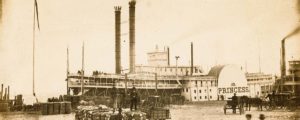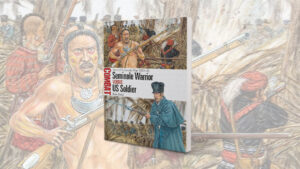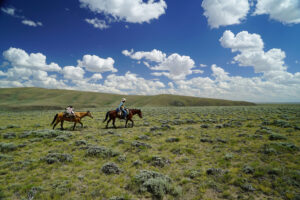Crow Dog’s attorney appealed all the way to the Supreme Court.
Bad blood boiled between Brulé Sioux leaders Spotted Tail (Sinte Gleska) and Crow Dog (Kangi Sunka). On the afternoon of August 5, 1881, Crow Dog left a tribal council at the Rosebud Agency and—with wife Pretty Camp and a child—started by wagon on the nine-mile drive home. The meeting had not resolved the men’s long-running political and personal disputes. In fact, Crow Dog and other council members had voiced their displeasure with Spotted Tail for taking a female relative of Crow Dog away from her disabled husband. It was their opinion Spotted Tail must return the woman to her husband.
Crow Dog’s route home would take him past Spotted Tail’s new government-built house, about two miles from Rosebud Agency. Shortly after Crow Dog drove off, Spotted Tail also left the council, headed in the same direction. Riding his horse at a lope, Spotted Tail soon caught up with the wagon. What happened next is disputed, but one thing is certain— Crow Dog shot Spotted Tail point-blank in the chest, killing him. The high-profile shooting was a significant event among the Lakotas, and the court case that followed would have a far-reaching impact on the federal government’s jurisdiction over Indians.
Spotted Tail, who became leader of the Ring tiospaye (band) in 1866, advocated peace with whites, who in turn considered him a friend. In 1876, when Spotted Tail restrained Brulé warriors from participating in what whites called the Great Sioux War, government officials dubbed him “head chief of all the Sioux bands,” although many Lakotas did not recognize this title. Crow Dog became head of the Orphan tiospaye in 1875, and Rosebud Indian Agent Cicero Newell appointed him captain of the Rosebud tribal police in 1879.
Spotted Tail and Crow Dog argued over many issues, including collection of payments from ranchers grazing cattle on tribal lands. On two occasions, Spotted Tail had government agents remove Crow Dog as head of the tribal police. Their last dispute, over the return of Crow Dog’s female relative, cost Spotted Tail his life. (Visit www.historynet.com to read two articles on Spotted Tail from the February 2006 Wild West.)
In accordance with Brulé custom, representatives of the tribal council met with Crow Dog’s family and Spotted Tail’s family to discuss the shooting death. The council decided that Crow Dog’s family had to pay restitution of eight horses, a blanket and cash to Spotted Tail’s family. This was done promptly and, as far as Brulé law was concerned, the case was closed.
Government agents, however, were outraged that the man responsible for the wanton killing of a good chief and good friend should be treated so leniently. They insisted that Crow Dog stand trial for murder. While interested in meting out justice, they also believed a court decision might expand their authority over the Indians.
Rosebud agency clerk Henry Lelar, in the absence of agent General John Cook, ordered Crow Dog’s arrest. When Crow Dog refused to go with the tribal police, they didn’t press the matter. Lelar then turned to Hollow Horn Bear, a leader of the Orphan band, to arrest not only Crow Dog but also Black Crow, a tribesman named as an accomplice. This time Crow Dog willingly submitted to the arrest, as did Black Crow (who, as was later proved, had nothing to do with the killing). Hollow Horn Bear escorted the pair to Fort Niobrara in Nebraska. A few interested parties suggested the federal government could not arrest an Indian for a crime committed against another Indian on tribal land. The few times this had happened before, the courts had thrown out the cases. But Spotted Tail had been no run-of-the-mill Indian, and many called for Crow Dog to pay for his crime. The case proceeded.
A federal marshal transported Crow Dog from Fort Niobrara to the Dakota territorial jail in Deadwood to await trial. Gideon C. Moody, the presiding judge, believed the federal court did have jurisdiction. Crow Dog had little money, so the court appointed Adoniram J. Plowman to defend him. Crow Dog did not speak English, and Plowman did not speak Lakota, so the two communicated through interpreters, including T.J. Whalen, the Rosebud postmaster and a meat distributor who was in jail himself and was later convicted of manslaughter in another case. District Attorney Hugh J. Campbell, who was prosecuting the Spotted Tail murder case for the government, had no problem securing witnesses to testify against Crow Dog. Plowman, on the other hand, struggled to find witnesses on his client’s behalf. Agent Cook hampered his efforts, while rumors circulated that Spotted Tail Junior, son of the dead chief, was bribing potential witnesses.
The trial began on March 16, 1882. The courtroom was packed with Deadwood residents and Brulé witnesses for the prosecution. Two conflicting accounts of the killing emerged. Prosecution witnesses stated Crow Dog was driving home after the August 5, 1881, council when he stopped his team of horses, climbed down from the wagon and pretended to work on a wheel. As Spotted Tail rode by, Crow Dog stood up and shot him. These witnesses said Spotted Tail was unarmed.
Crow Dog had little corroboration for his account. Although his wife, Pretty Camp, was in the wagon that day, Moody ruled she could not testify. The judge also refused to allow the jury to hear Crow Dog and Pretty Camp’s notarized affidavit about the incident. Crow Dog alleged that while he did stop that August day to fix his wagon, he was “passing water” when Spotted Tail rode up. Crow Dog walked to the head of his horses as Spotted Tail reined his own horse to a stop and pulled a pistol. At that point, Crow Dog fired his shotgun from the hip, killing Spotted Tail in self-defense.
In his closing argument, Plowman stated the court had no say in the matter, as the federal government lacked jurisdiction over Indians who commit crimes against other Indians. But Moody instructed the jurors to ignore jurisdictional issues and only consider whether Crow Dog had committed murder. Deliberations began at 4:45 p.m. on March 23 and continued through the night. The next morning, at 9:15, the jury returned its verdict: Crow Dog was guilty of murder.
Moody sentenced Crow Dog to hang. Testimony came to light suggesting Spotted Tail did have a pistol on him at the time of the shooting, but the judge would not allow a new trial. Crow Dog’s attorney appealed to the Territorial Supreme Court at Yankton, Dakota Territory, which upheld the lower court’s verdict in October 1882. But Plowman was not done. He appealed the case to the U.S. Supreme Court.
By that time, many in the white community believed justice would be served without Crow Dog having to pay the ultimate price. Deadwood newspapers called for leniency, and 16 members of the grand jury sent a letter to U.S. President Chester A. Arthur requesting Crow Dog’s sentence be commuted. The 12 members of the trial jury also signed a petition asking the president to show clemency. Similar petitions came from 10 Army officers stationed at Fort Niobrara and from six Christian missionaries of various denominations. Arthur granted a temporary stay of execution.
Crow Dog, meanwhile, had befriended his jailer, Demetrius Seldon Billington, who allowed the prisoner to leave his cell to roam the hillsides in search of kinnikinnick to mix with his tobacco. While under guard, Crow Dog witnessed the hanging of James Leighton Gilmore, who had murdered fellow mule skinner Bisente Ortez. An inmate who knew some Lakota told Crow Dog he would be next, so Crow Dog asked to return to Rosebud to put his affairs in order. The authorities gave permission. Crow Dog traveled home alone and then returned to Deadwood to meet his fate.
In August 1883, the District Court reset Crow Dog’s execution date for January 14, 1884. In October 1883, the U.S. Supreme Court agreed to hear the case. On December 17, less than a month before Crow Dog was to step onto the gallows, the high court ruled unanimously that the federal government had no jurisdiction over an Indian who committed a crime against another Indian on a reservation. Crow Dog was released and returned to his family at Rosebud.
The Supreme Court’s decision caused a public outcry. Murderer Crow Dog had beaten the system. Government officials who sought increased federal authority over the tribes pushed their case. Supporting them were Eastern reform organizations that believed Indians should be assimilated into the general culture. The U.S. Congress responded to the court’s decision and public outcry by passing the Major Crimes Act of 1885, which placed Indians under federal authority for murder and 14 other felonies. It remains in effect today.
As for Crow Dog, he made the most of his freedom and did not shy away from controversy on the reservation. He asserted himself as a leader of the 1890 Ghost Dance religious movement, which ended with the tragic December 29, 1890, fight at Wounded Knee, S.D. Crow Dog, however, kept his followers from turning to violence and had surrendered to the military. The old chief, whom some considered a hero and others a troublemaker, adhered to traditional Lakota ways until his death on the Rosebud Reservation in 1910.
Originally published in the December 2009 issue of Wild West. To subscribe, click here.




